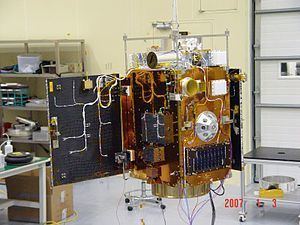Operator KARI Reference system Geocentric Inclination 80° Launch mass 90 kg Rocket Naro-1 | Contractor Khrunichev/KARI Regime Low Earth Period 1.7 hours Launch date 25 August 2009 Launch site Naro Space Center | |
 | ||
Mission duration 2 years (planned)
Failed to orbit Perigee 300 kilometres (190 mi) Similar STSAT‑2C, Kitsat‑1, Nanosat‑1B, Progress M‑66, PharmaSat | ||
STSAT-2A (Science and Technology Satellite 2A) was a satellite launched by the Korea Aerospace Research Institute (KARI), the national space agency of South Korea, from the Naro Space Center in Goheung County, South Jeolla using the Naro-1 (KSLV-1) rocket.
The 100-kilogram (220 lb) satellite carried a Lyman-alpha Imaging Solar Telescope (LIST) as well as Satellite laser ranging (SLR) payload.
The Satellite Technology Research Center (SaTReC) developed STSAT-2A as a sun observation, satellite laser ranging and engineering and technology demonstration sponsored by the Ministry of Science and Technology. It was expected to be operational for about two years, and was scheduled to be launched between 2005 and 2007.
The Satellite Laser Ranging (SLR) instrument was intended to measure the orbit of STSAT-2A, in order to investigate variations in its orbit.
It was a followup to STSAT-1, which was launched using a Kosmos-3M rocket on September 27, 2003. Originally a Dual-channel Radiometers for Earth and Atmosphere Monitoring (DREAM) Microwave radiometer was intended as the principal payload of STSAT-2A for an expected launch in 2007. The Laser Retro-reflector Array (LRA) was described as an early expected payload for STSAT-2A which would consist of nine retro-reflectors in a mechanical casing.
STSAT-2A has three missions, the indigenous research and development to place a satellite into low orbit, development of indigenous spacecraft, and the ability to develop scientific payloads.
STSAT-2A was launched on the maiden flight of the Naro-1 rocket, which lifted off the Naro Space Centre, on the southern coast of South Korea at 08:00 GMT on 25 August 2009. The launch failed to place STSAT-2 into orbit after half of the payload fairing failed to separate. This resulted in the second stage being too heavy to reach orbit, and it fell back to Earth along with the satellite. Further investigation is ongoing. A second satellite, STSAT-2B, was launched on June 10, 2010, but the launch vehicle failed again.
